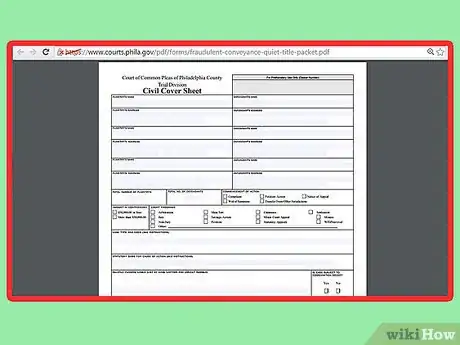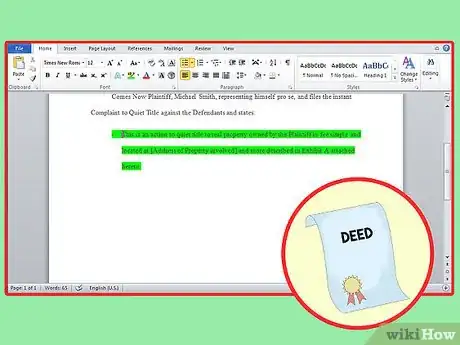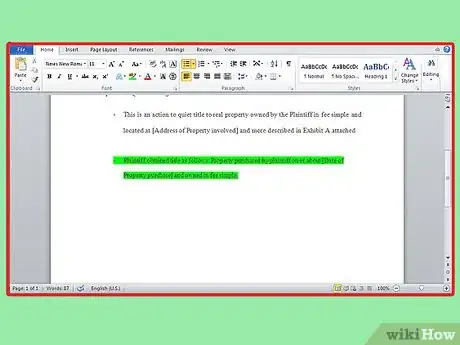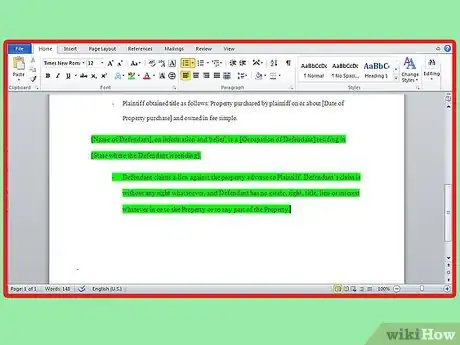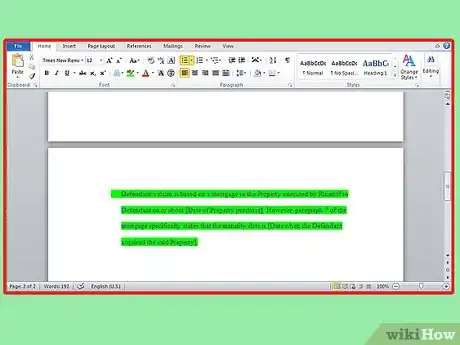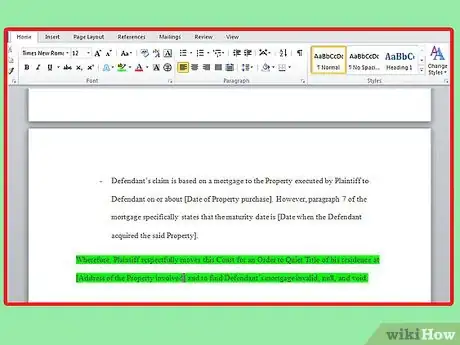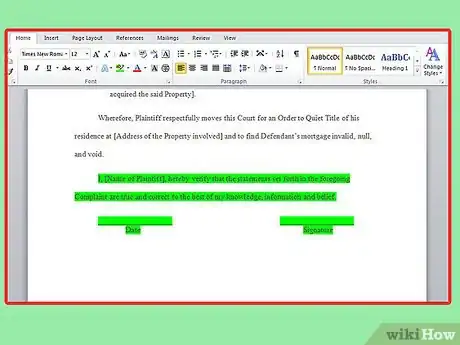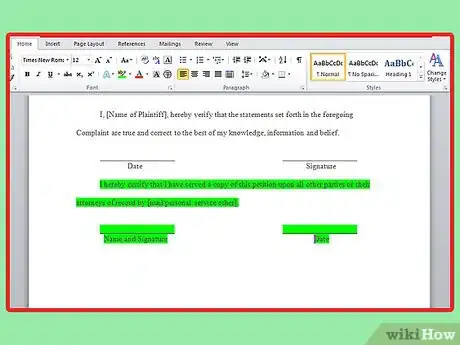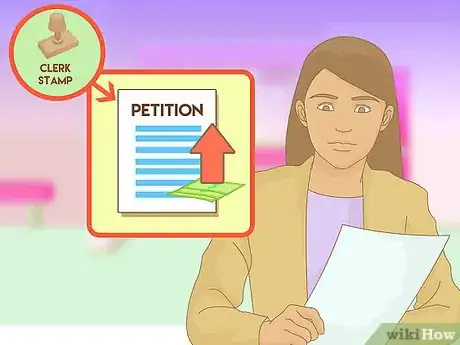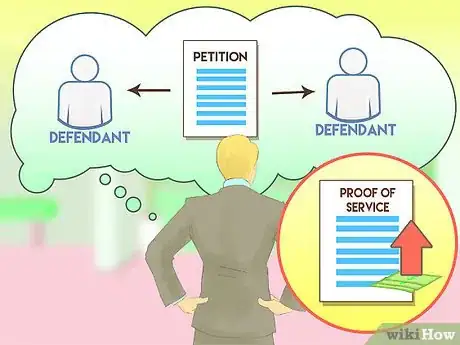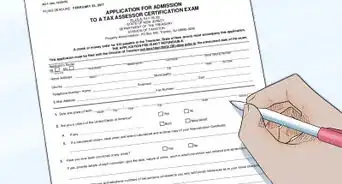This article was co-authored by Clinton M. Sandvick, JD, PhD. Clinton M. Sandvick worked as a civil litigator in California for over 7 years. He received his JD from the University of Wisconsin-Madison in 1998 and his PhD in American History from the University of Oregon in 2013.
wikiHow marks an article as reader-approved once it receives enough positive feedback. In this case, 94% of readers who voted found the article helpful, earning it our reader-approved status.
This article has been viewed 84,646 times.
There are many situations when you might want to file to “quiet title.” For example, you may be unsure whether or not you own all of the rights to a piece of property that you are trying to sell. For example, a prior owner may have granted an easement to someone else. If you want to sell the land, you will want to quiet title. Alternately, you may want to quiet title when someone asserts a lien which you believe does not have merit. To file a quiet title action, you will first need to draft a petition.
Steps
Preparing to File
-
1Understand quiet title. You bring a petition to quiet title when you need to resolve disputes over a piece of property. The action “quiets” the dispute—hence the name. The person bringing a suit to quiet title would name anyone as defendant who might claim an interest in the property. Suits to quiet title are most common when:[1]
- You want to dispute someone’s mortgage or lien on the property.
- You are uncertain about the boundary.
- Someone has used an easement on your property without the easement having been recorded on the deed.
-
2Get a copy of your deed. You can get a copy of the deed to see if there are any liens listed on the property. For example, a mortgage may have been recorded but never released. Or someone may be using your property by claiming to have an easement when one is not listed on the deed.
- You may also want to consider hiring a title company to search the chain of title. By performing this search, you might uncover liens or other encumbrances listed on prior deeds. Anyone who owned a lien or other interest in the property could reappear and claim to still own an interest in your property. Accordingly, a title search can uncover any “clouds” to your title. Whoever owns these old interests in the property can then be added as defendants to your quiet title lawsuit.
- To find title companies, you can search online or in the Yellow pages.
Advertisement -
3Meet with an attorney. You should consider meeting with a lawyer to discuss whether you need to bring a quiet title action. An experienced attorney can look over the facts of your case and offer advice tailored to your situation.
- To find an experienced lawyer, you can visit your state’s bar association, which should have a referral program. You should find an attorney with experience in real estate or property law.
Filing for Quiet Title
-
1Get a form. In order to bring an action to quiet title, you first have to petition the court. You begin the process by filing a petition. Some courts may have prepared “fill in the blank” forms for you to use. An example of a blank form from the Pennsylvania courts is available at https://www.courts.phila.gov/pdf/forms/fraudulent-conveyance-quiet-title-packet.pdf.
- Ask your court clerk if there is a form available for your court.
- You need to file in the county where most of the property is located. You can find this court address by looking on the web or in a phone book.
-
2Draft your own petition. If your courthouse does not have a form to fill out, then you will have to draft your own. Open a word processing document and set the font to a standard size and style (e.g., Times New Roman 12 point). Make sure to double-space the document.
-
3Insert a caption and title. You should put the caption at the top of the document. A caption lists the court’s name and location, as well as the parties and the case number. It may also name the judge. As the person filing the petition, you are the “Plaintiff.” The “Defendant” is whoever might claim an interest in your property.
- Place the court name at the top, then the parties aligned on the left, with the case number at the right. You will get the case number when you file the petition.
- In addition to naming anyone you know who claims an interest in the property, you should also name “John Does 1-100, or any other person, known or unknown, with an interest in the property” as defendants in your suit. By doing this, your lawsuit can be binding on anyone you don’t know who might have an interest in the property.
- A couple lines below the caption, you can enter the title of the petition. Insert the words “Action to Quiet Title” or “Complaint to Quiet Title” in bold, all caps.[2]
- Place the court name at the top, then the parties aligned on the left, with the case number at the right. You will get the case number when you file the petition.
-
4Identify yourself. The body of your petition will include important information about the dispute. You should number your paragraphs. The body will begin with your name, address, and whether you are representing yourself “pro se.” If you have a lawyer, then include your lawyer’s name and address.
- Type: “Comes Now Plaintiff, Michael Smith, representing himself pro se, and files the instant Complaint to Quiet Title against the Defendants and states:”[3]
-
5Identify the property. You should identify the property by both its legal description (which you can find on the deed) and the street address or common designation. See How to Get a Legal Description of Property for how to find the legal description of property.
- In a separate paragraph, identify the property. “This is an action to quiet title to real property owned by the Plaintiff in fee simple and located at 144 Mayflower Road, Burr Ridge, Illinois and more described in Exhibit A attached hereto.”[4]
- You should remember to attached a copy of the deed, which includes the legal description of property, as Exhibit A to your complaint.
-
6Describe how you took title. You should explain when you purchased the property. Sample language could be, “Plaintiff obtained title as follows: Property purchased by plaintiff on or about June 22, 1999 and owned in fee simple.”[5]
-
7Identify defendants. In numbered paragraphs, identify any named defendants.[6] For example, “Defendant Lionel Smith, on information and belief, is a lawyer residing in Chicago, IL.”
- After you identify the defendants, explain their interest in the property. “Defendant claims a lien against the property adverse to Plaintiff. Defendant’s claim is without any right whatsoever, and Defendant has no estate, right, title, lien or interest whatever in or to the Property or to any part of the Property.”[7]
-
8Add other relevant facts. These facts are relevant depending on your situation. Specifically, you should explain why the defendant’s claimed interest is not legitimate. For example, the defendant might have claimed a mortgage but the mortgage has already matured.[8]
- You could write, “Defendant’s claim is based on a mortgage to the Property executed by Plaintiff to Defendant on or about June 22, 1999. However, paragraph 7 of the mortgage specifically states that the maturity date is December 31, 2014.”[9]
-
9Insert a conclusion. Always conclude the petition/complaint with a prayer for relief. The court needs to know what relief you are asking for.
- Sample language could be: “Wherefore, Plaintiff respectfully moves this Court for an Order to Quiet Title of his residence at 144 Mayflower Road, Burr Ridge, IL and to find Defendant’s mortgage invalid, null, and void.”[10]
-
10Add a signature block. You need to verify your petition by including a verification statement and by signing the petition.
- A sample verification might read: “I, [insert name], hereby verify that the statements set forth in the foregoing Complaint are true and correct to the best of my knowledge, information and belief.”[11]
- Also add the date beside your signature.
-
11Include a notary block, if necessary. You may need your petition notarized. If so, you can find an appropriate notary block for your state by searching the web. Type “acknowledgment” or “notary” along with your state.
- Make sure to only sign your petition in front of a notary. There should be a notary in the courthouse. You will need to show personal identification, such as a valid driver’s license or passport.
-
12Attach a certificate of service. At the end of your document, you need to describe how you served notice of the suit to the defendants. At the bottom of the petition, you can type something like the following:
- “I hereby certify that I have served a copy of this petition upon all other parties or their attorneys of record by [mail/personal service/other].” Then print and sign you name, including the date.[12]
- If you don’t know what are acceptable methods of service, you should call the court clerk before filing your motion. The clerk can tell you how to serve. Typically, you can serve notice personally using the sheriff, a process server, or someone over the age of 18 who is not a party to the suit. The process server then personally serves notice on each defendant.
- In some courts, you can also have the server mail the notice to each defendant.
-
13File the petition. You need to gather all attachments and take the complete motion to the court clerk. Make several copies and have the clerk stamp all of your copies. One copy is for each defendant and at least one copy is for your records. You will file the original.
- You will probably have to pay a filing fee. The fee amount will vary depending on state and county. If you cannot afford the fee, then ask for a fee waiver form and fill it out.[13]
-
14Serve notice. You must send a copy of the petition to all named defendants. You should arrange service before filing or shortly thereafter.
- Make sure the server fills out a Proof of Service form (sometimes called an “Affidavit of Service”). You can get the form from the court clerk. After service has been made, you need to file the Proof of Service form with the court.
References
- ↑ http://www.nolo.com/dictionary/quiet-title-action-term.html
- ↑ http://www.toledoblade.com/attachment/2014/03/07/Copy-of-Complaint.pdf
- ↑ http://www.toledoblade.com/attachment/2014/03/07/Copy-of-Complaint.pdf
- ↑ http://www.toledoblade.com/attachment/2014/03/07/Copy-of-Complaint.pdf
- ↑ http://www.toledoblade.com/attachment/2014/03/07/Copy-of-Complaint.pdf
- ↑ http://www.toledoblade.com/attachment/2014/03/07/Copy-of-Complaint.pdf
- ↑ http://www.toledoblade.com/attachment/2014/03/07/Copy-of-Complaint.pdf
- ↑ http://www.toledoblade.com/attachment/2014/03/07/Copy-of-Complaint.pdf
- ↑ http://www.toledoblade.com/attachment/2014/03/07/Copy-of-Complaint.pdf
- ↑ http://www.toledoblade.com/attachment/2014/03/07/Copy-of-Complaint.pdf
- ↑ https://www.courts.phila.gov/pdf/forms/fraudulent-conveyance-quiet-title-packet.pdf
- ↑ https://www.courts.phila.gov/pdf/forms/fraudulent-conveyance-quiet-title-packet.pdf
- ↑ https://www.courts.phila.gov/pdf/forms/fraudulent-conveyance-quiet-title-packet.pdf
About This Article
A quiet title is a document that proves your property ownership when a dispute occurs. For example, if someone is claiming ownership of your land, you can file for a quiet title to settle the claim. To file a petition for a quiet title, you’ll need a copy of your deed to prove your ownership. Then, you’ll need to get a form from your local court or write your own petition. In the petition, identify yourself, your property, and when you bought the property. Make sure you attach a copy of your deed as evidence. In some states, you’ll also need to get your petition signed by a notary. Once you’ve filed your petition, serve notice to anyone disputing your ownership. For more tips from our Legal co-author, including how to get your petition notarized, read on.



